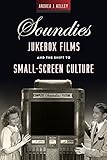Soundies Jukebox Films and the Shift to Small-Screen Culture / Andrea J. Kelley.
Material type: TextSeries: Techniques of the Moving ImagePublisher: New Brunswick, NJ : Rutgers University Press, [2018]Copyright date: ©2018Description: 1 online resource (194 p.) : 18 figuresContent type:
TextSeries: Techniques of the Moving ImagePublisher: New Brunswick, NJ : Rutgers University Press, [2018]Copyright date: ©2018Description: 1 online resource (194 p.) : 18 figuresContent type: - 9780813586342
- 9780813586366
- online - DeGruyter
- Issued also in print.
| Item type | Current library | Call number | URL | Status | Notes | Barcode | |
|---|---|---|---|---|---|---|---|
 eBook
eBook
|
Biblioteca "Angelicum" Pont. Univ. S.Tommaso d'Aquino Nuvola online | online - DeGruyter (Browse shelf(Opens below)) | Online access | Not for loan (Accesso limitato) | Accesso per gli utenti autorizzati / Access for authorized users | (dgr)9780813586366 |
Browsing Biblioteca "Angelicum" Pont. Univ. S.Tommaso d'Aquino shelves, Shelving location: Nuvola online Close shelf browser (Hides shelf browser)

|

|

|

|

|

|

|
||
| online - DeGruyter Junctures in Women's Leadership : Higher Education / | online - DeGruyter Hollywood on Location : An Industry History / | online - DeGruyter Reel Inequality : Hollywood Actors and Racism / | online - DeGruyter Soundies Jukebox Films and the Shift to Small-Screen Culture / | online - DeGruyter Dwelling in Resistance : Living with Alternative Technologies in America / | online - DeGruyter Complicated Lives : Girls, Parents, Drugs, and Juvenile Justice / | online - DeGruyter New York City Politics : Governing Gotham / |
Frontmatter -- Contents -- Introduction: Soundles Jukebox Films -- Part I. Small- Screen Encounters and Spatial Practices -- 1. The Look- Listening Machine: The Panoram Jukebox and New Screen Practices -- 2. The Sites of Soundles: The Dynamics of Space and Screen -- 3. Mobilizing Space: The Panoram Goes to War -- Part II. Short Forms and Enduring Formations -- 4. Up Close and Personal: The Shifting Aesthetics of the Jukebox Short -- 5. "A Swing Half Breed": Soundles' Hybrid Identities and Raced Attractions -- 6. Postwar Screens: Soundles on Television and the Rehash of the Film Jukebox -- Conclusion: Short and Sweet: Rescaling Screen Culture -- Acknowledgments -- Notes -- Bibliography -- Index -- About the Author
restricted access online access with authorization star
http://purl.org/coar/access_right/c_16ec
Soundies Jukebox Films and the Shift to Small-Screen Culture is the first and only book to position what are called "Soundies" within the broader cultural and technological milieu of the 1940s. From 1940 to 1946, these musical films circulated in everyday venues, including bars, bowling alleys, train stations, hospitals, and even military bases. Viewers would pay a dime to watch them playing on the small screens of the Panoram jukebox. This book expands U.S. film history beyond both Hollywood and institutional film practices. Examining the dynamics between Soundies' short musical films, the Panoram's film-jukebox technology, their screening spaces and their popular discourse, Andrea J. Kelley provides an integrative approach to historic media exhibition. She situates the material conditions of Soundies' screening sites alongside formal considerations of the films and their unique politics of representation to illuminate a formative moment in the history of the small screen.
Issued also in print.
Mode of access: Internet via World Wide Web.
In English.
Description based on online resource; title from PDF title page (publisher's Web site, viewed 30. Aug 2021)


